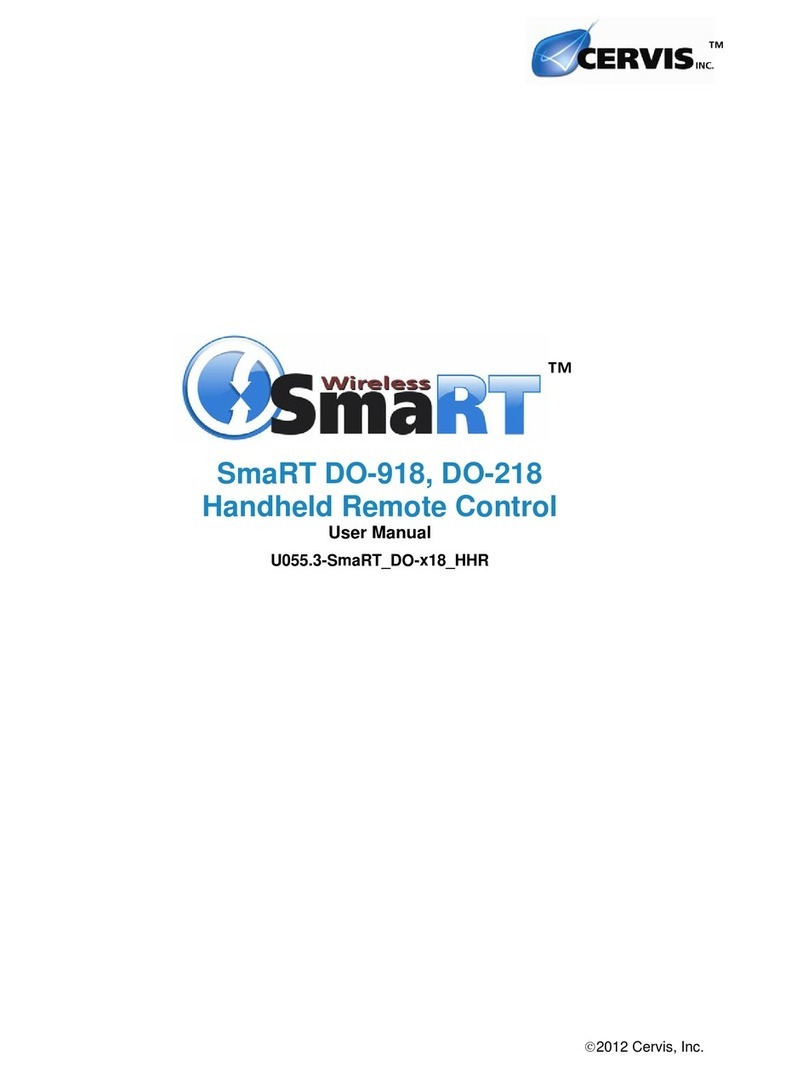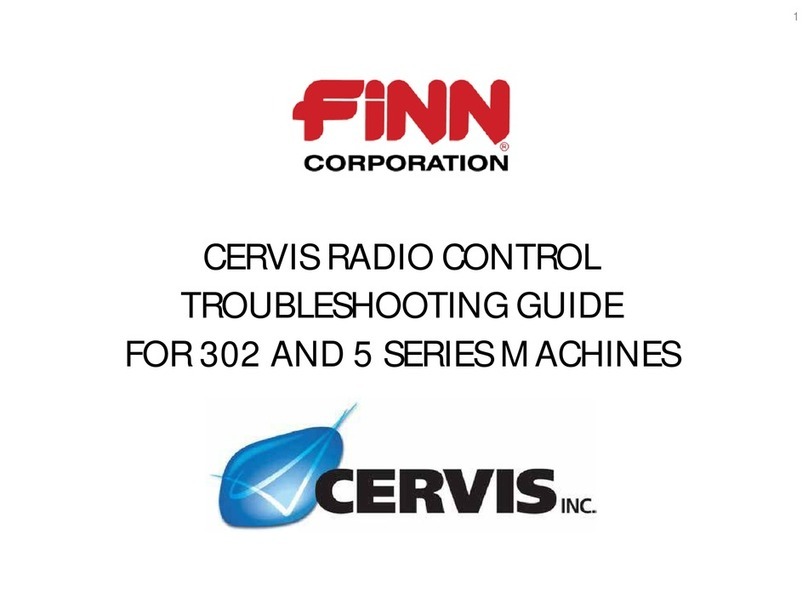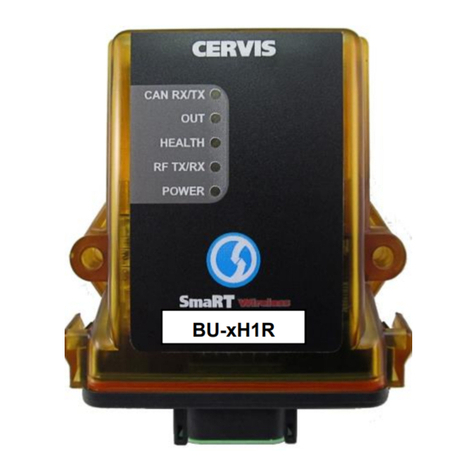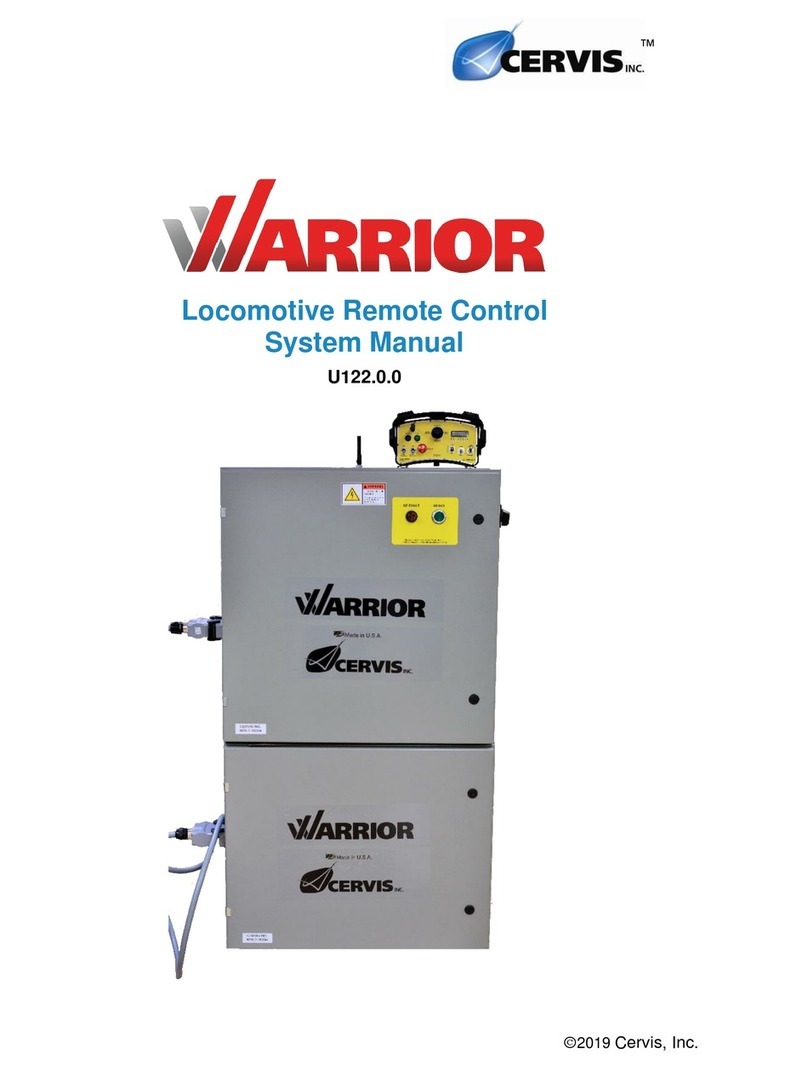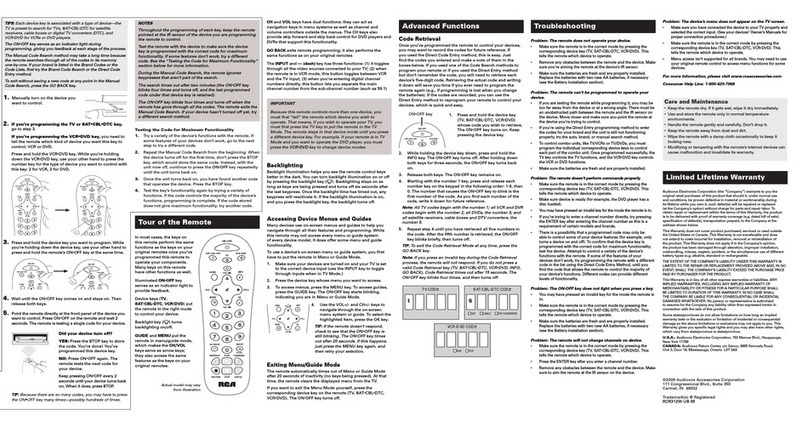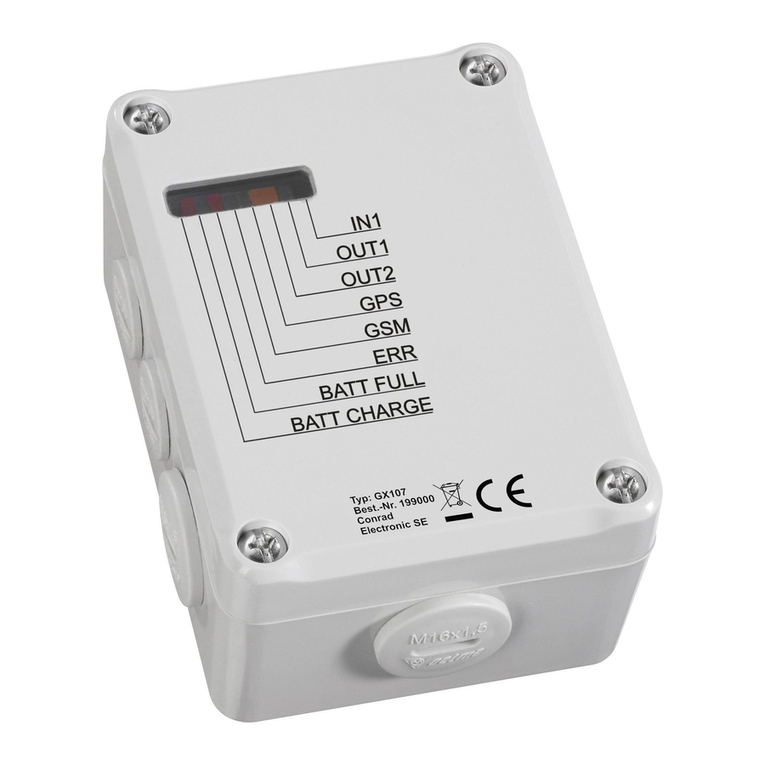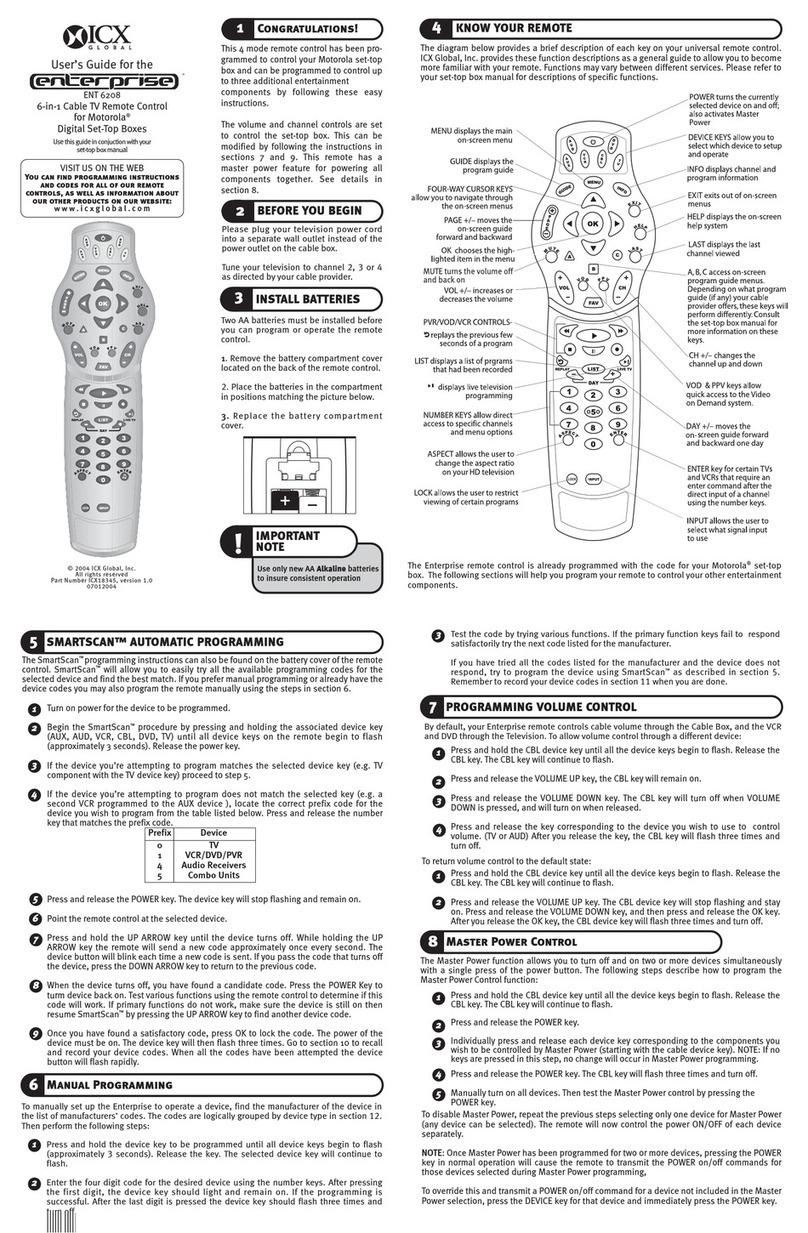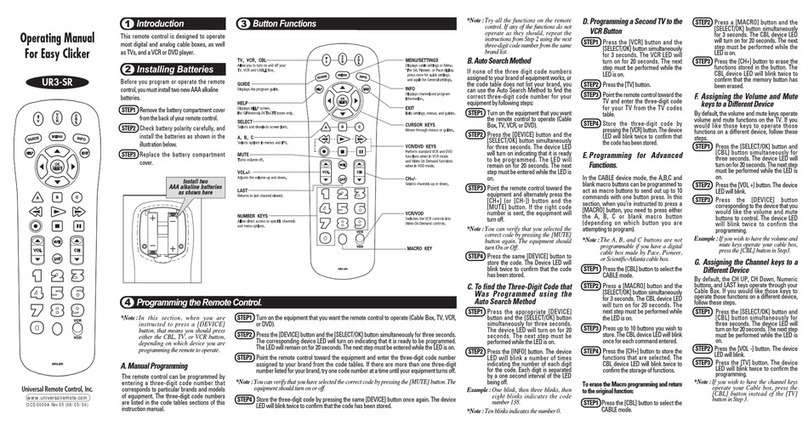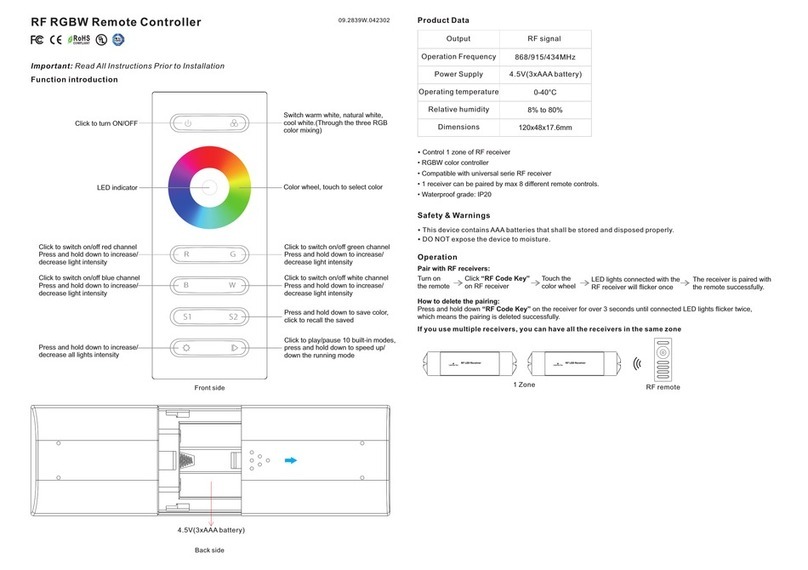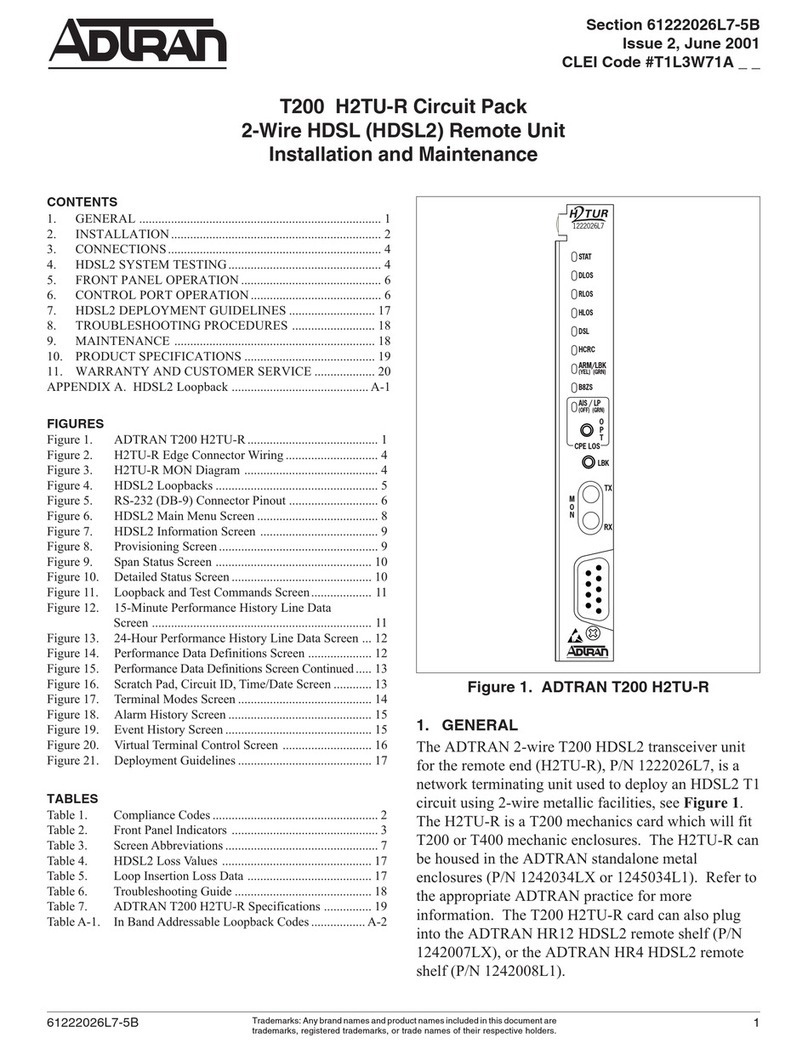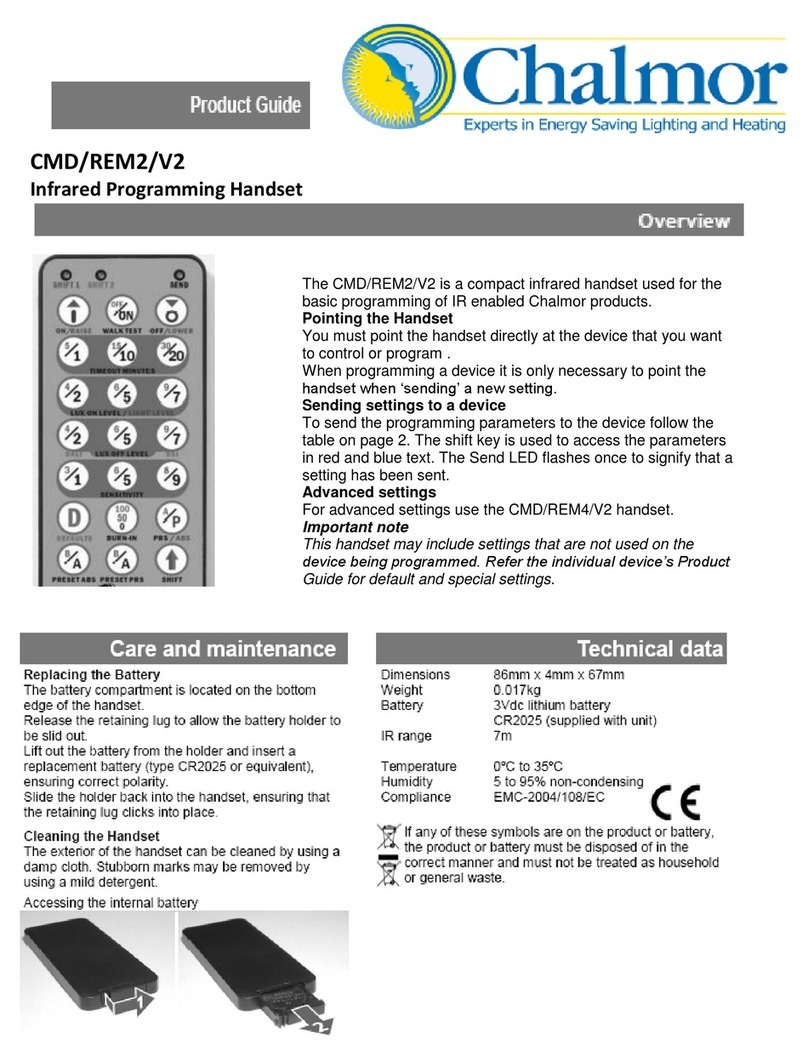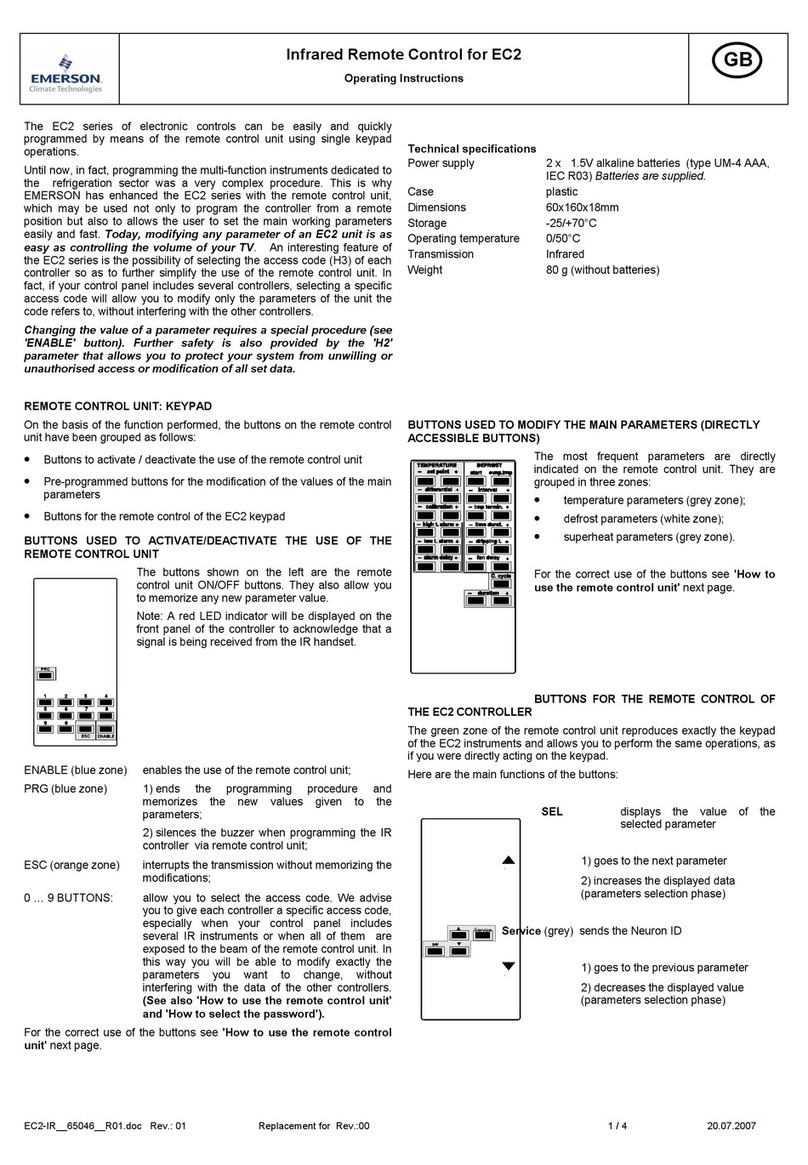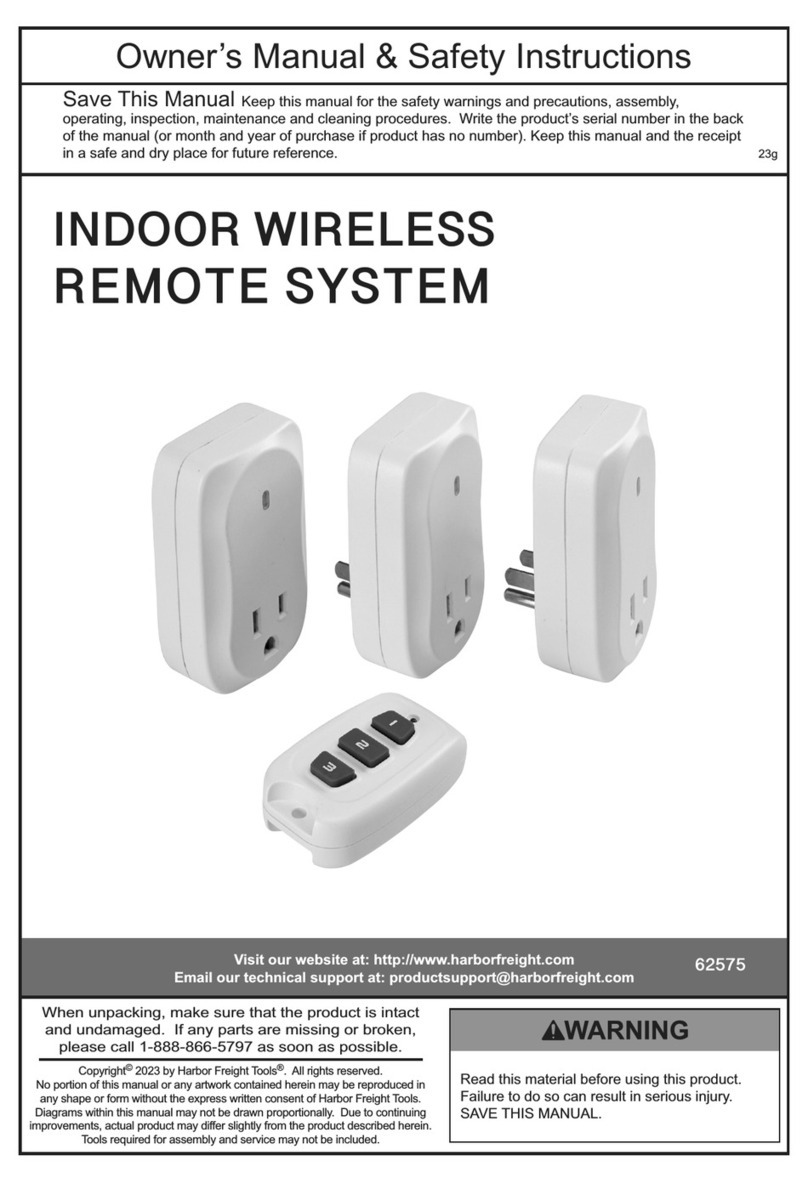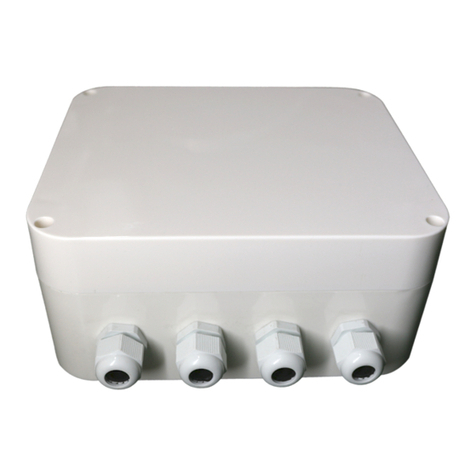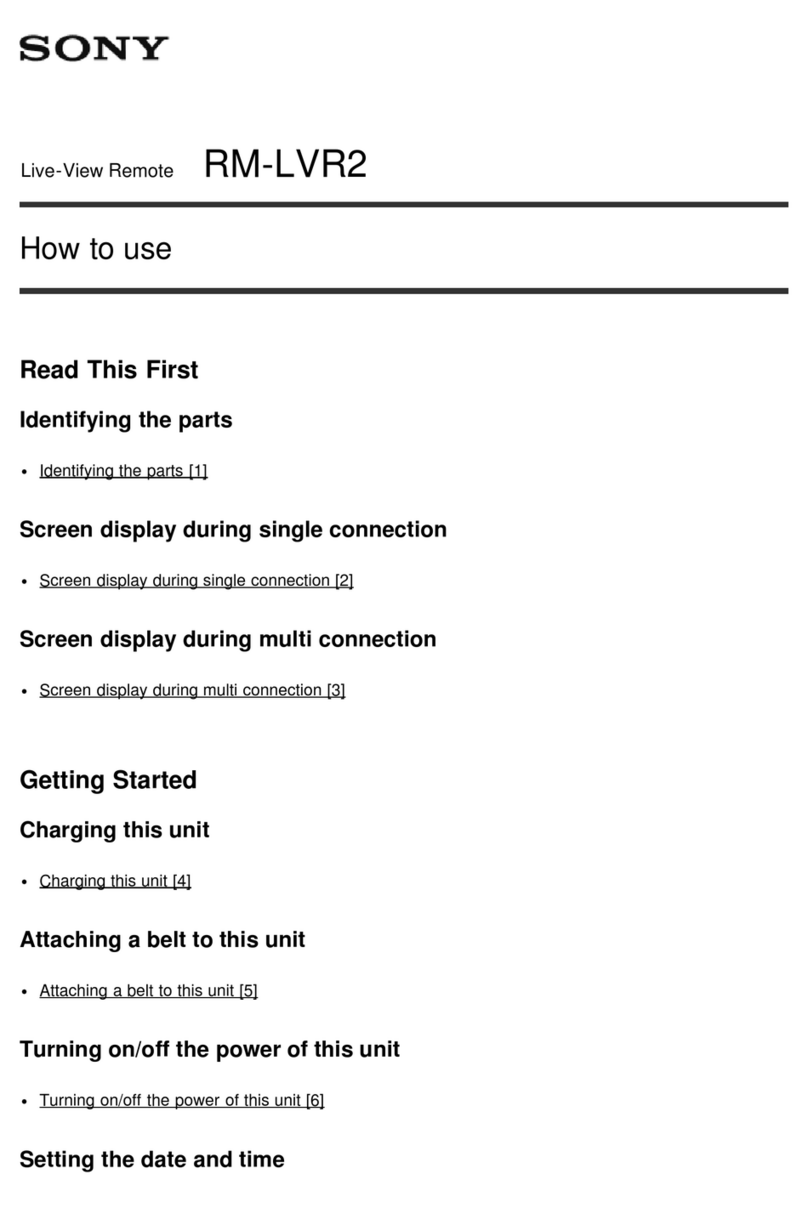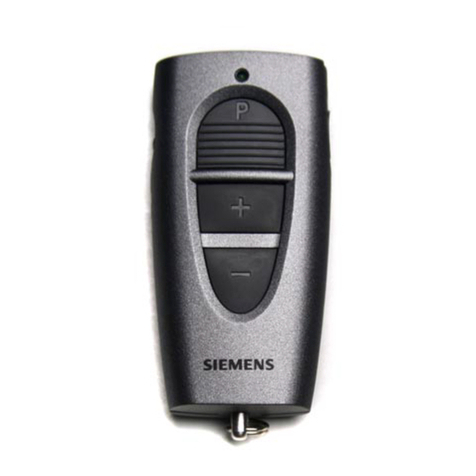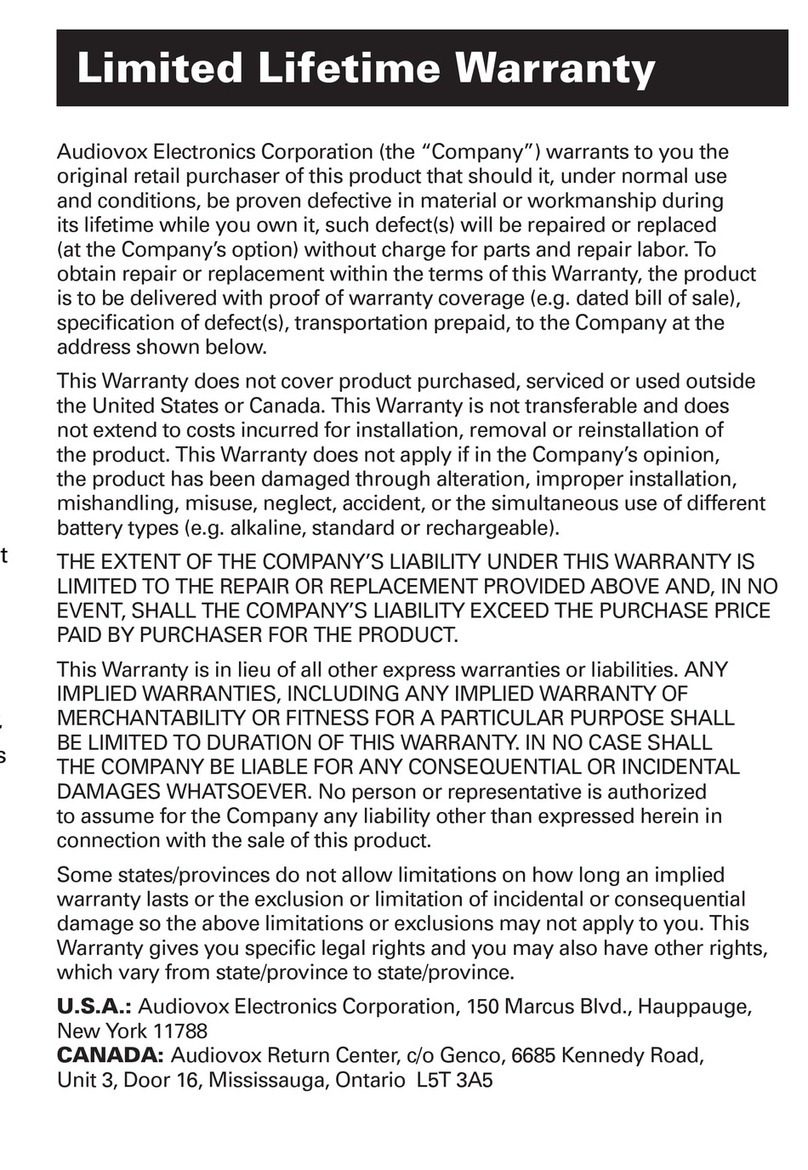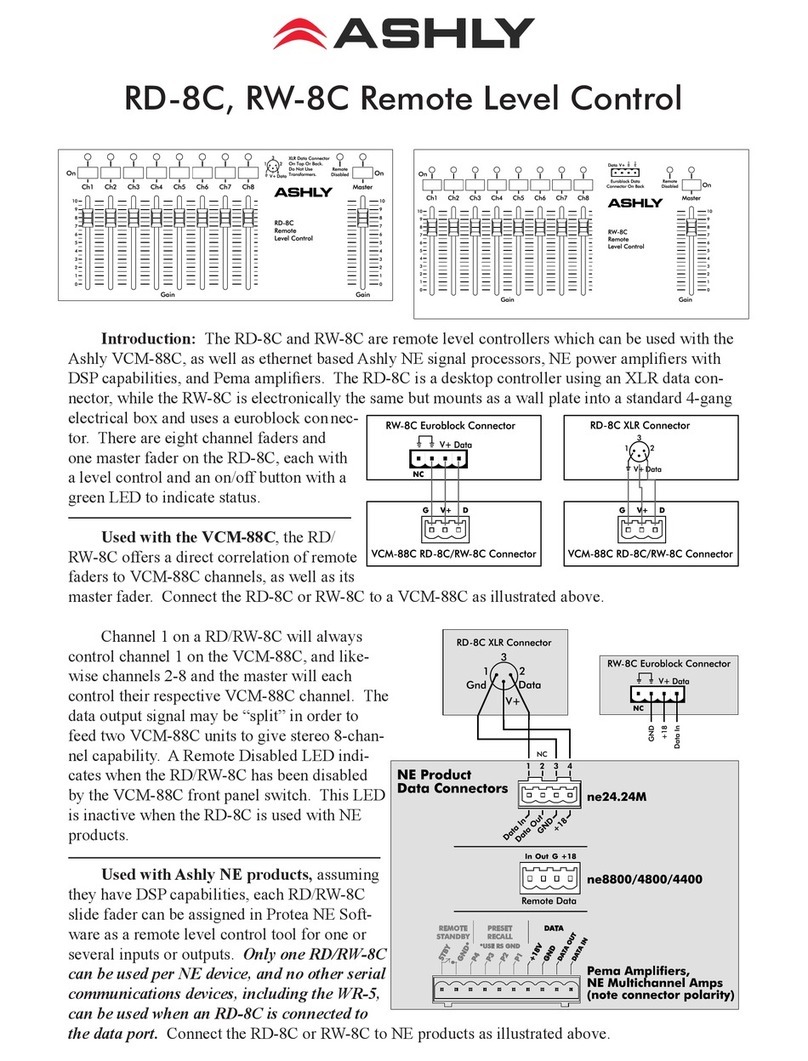Cervis Warrior 32 HH2S-9XL10 User manual

2017 Cervis, Inc.
HH2S-9XL10
Handheld Remote Manual
U101.1.0
™

This document is the property of Cervis, Inc. and cannot be copied, modified, e-mailed, or reproduced without the express
prior written consent of Cervis, Inc.
Cervis, Inc. reserves the right to change this manual or edit, delete, or modify any information without prior notification.
FCC Statements
15.19 –Two Part Warning
This device complies with Part 15 of the FCC rules. Operation is subject to the following two conditions:
(1) This device may not cause harmful interference and
(2) This device must accept any interference received, including interference that may cause undesired operation.
15.21 –Unauthorized Modification
NOTICE: The manufacturer is not responsible for any unauthorized modifications to this equipment made by the user. Such modifications could
void the user’s authority to operate the equipment.
15.105(b) –Note:
This equipment has been tested and found to comply with the limits for a Class B digital device, pursuant to Part 15 of the FCC Rules. These
limits are designed to provide reasonable protection against harmful interference in a residential installation. This equipment generates, uses and
can radiate radio frequency energy and, if not installed and used in accordance with the instructions, may cause harmful interference to radio
communications. However, there is no guarantee that interference will not occur in a particular installation. If this equipment does cause harmful
interference to radio or television reception, which can be determined by turning the equipment off and on, the user is encouraged to try to
correct the interference by one or more of the following measures:
Reorient or relocate the receiving antenna.
Increase the separation between the equipment and receiver.
Connect the equipment into an outlet on a circuit different from that to which the receiver is connected.
Industry Canada Statement
This device complies with Canadian RSS-210.
The installer of this radio equipment must ensure that the antenna is located or pointed such that it does not emit RF field in excess of Health Canada limits for
the general population; consult Safety Code 6, obtainable from Health Canada’s website www.hc-sc.gc-ca/rpb.
Le présent appareil est conforme aux CNR d'Industrie Canada applicables aux appareils radio
exempts de licence. L'exploitation est autorisée aux deux conditions suivantes : (1) l'appareil ne doit pas produire de brouillage, et (2) l'utilisateur de l'appareil
doit accepter tout brouillage
radioélectrique subi, même si le brouillage est susceptible d'en compromettre le fonctionnement.
Industry Canada Statement
This device complies with Industry Canada licence-exempt RSS standard(s). Operation is subject to the following two conditions: (1) this device may not cause
interference, and (2) this device must accept any interference, including interference that may cause undesired operation of the device.
Le présent appareil est conforme aux CNR d'Industrie Canada applicables aux appareils radio exempts de licence. L'exploitation est autorisée aux deux
conditions suivantes : (1) l'appareil ne doit pas produire de brouillage, et (2) l'utilisateur de l'appareil doit accepter tout brouillage radioélectrique subi, même si
le brouillage est susceptible d'en compromettre le fonctionnement.
IC Unlicensed Devices EIRP Statements for Removable Antennas
Part 1: Under Industry Canada regulations, this radio transmitter may only operate using an antenna of a type and maximum (or lesser) gain
approved for the transmitter by Industry Canada. To reduce potential radio interference to other users, the antenna type and its gain should be so
chosen that the equivalent isotropically radiated power (e.i.r.p.) is not more than that necessary for successful communication.
Conformément à la réglementation d'Industrie Canada, le présent émetteur radio peut fonctionner avec une antenne d'un type et d'un gain maximal (ou
inférieur) approuvé pour l'émetteur par Industrie Canada. Dans le but de réduire les risques de brouillage radioélectrique à l'intention des autres utilisateurs,
il faut choisir le type d'antenne et son gain de sorte que la puissance isotrope rayonnée équivalente (p.i.r.e.) ne dépasse pas l'intensité nécessaire à
l'établissement d'une communication satisfaisante.
Part 2: This radio transmitter (LOBSRF-305) has been approved by Industry Canada to operate with the antenna type listed below with the
maximum permissible gain and required antenna impedance for each antenna type indicated. Antenna types not included in this list, having a
gain greater than the maximum gain indicated for that type, are strictly prohibited for use with this device.
Le présent émetteur radio (LOBSRF-305) a été approuvé par Industrie Canada pour fonctionner avec les types d'antenne énumérés ci-dessous et ayant un
gain admissible maximal et l'impédance requise pour chaque type d'antenne. Les types d'antenne non inclus dans cette liste, ou dont le gain est supérieur
au gain maximal indiqué, sont strictement interdits pour l'exploitation de l'émetteur.

HH2S-9XL10 Handheld Remote
. 2017 Cervis, Inc
i
Table of Contents
Table of Contents.......................................................................................................................... i
List of Figures ............................................................................................................................... i
Cervis Inc. Safety Precautions ................................................................................................... ii
Warning: Operator Control Check............................................................................................. iii
1.0 Warrior Handheld Remote (HH2S-9XL10).......................................................................... 1
1.1 HH2S-9XL10 Battery Installation..................................................................................... 2
1.2 HH2S-9XL10 Battery Warning and Shutdown................................................................ 3
1.3 System Startup.................................................................................................................. 3
2.0 Associating a Handheld with a Receiver........................................................................... 4
2.1 Two Unlock Association Methods .................................................................................. 4
2.1.1 Unlock Association Method 1....................................................................................... 4
2.1.2 Unlock Association Method 2....................................................................................... 5
2.2 Associate a Handheld to a Receiver............................................................................... 5
3.0 HH2S-9XL10 Handheld Factory Reset (Memory Clear).................................................... 6
4.0 HH2S-9XL10 Handheld Specifications............................................................................... 7
Appendix A: Exposure to Radio Frequency Energy ................................................................ 8
Appendix B: RF Exposure Considerations ............................................................................... 8
List of Figures
Figure 1. Warning: Operator Control Check Label ....................................................................iii
Figure 2. HH2S-9XL10 LED and Button Descriptions ................................................................1
Figure 3. Warrior HH2S-9XL10 Transmitter Warnings and Precautions ..................................1
Figure 4. HH2S-9XL10 Battery Installation ..................................................................................2
Figure 5. HH2S-9XL10 Remote Low Battery Warning and Auto-Shutdown.............................3
Figure 6. System Startup...............................................................................................................3
Figure 7. Receiver SW01 DIP Switch 8 (Associate Lock)...........................................................4
Figure 8. Associate Step 2 ............................................................................................................5
Figure 9. HH2S-9XL10 with Numbered Buttons..........................................................................6

U101.1.0
ii
Cervis Inc. Safety Precautions
Read and follow all instructions.
Failure to abide by Safety Precautions may result in equipment failure, loss of
authority to operate the equipment, and personal injury.
Use and maintain proper wiring. Follow equipment manufacturer instructions.
Improper, loose, and frayed wiring can cause system failure, equipment damage, and
intermittent operation.
Changes or modifications made to equipment not expressly approved by the
manufacturer will void the warranty.
Owner/operators of the equipment must abide by all applicable Federal, State, and
Local laws concerning installation and operation of the equipment. Failure to comply
could result in penalties and could void user authority to operate the equipment.
Make sure that the machinery and surrounding area is clear before operating. Do not
activate the remote control system until certain that it is safe to do so.
Turn off the handheld remote remove and power from the receiver before attempting
any maintenance. This will prevent accidental operation of the controlled machinery.
Use a damp cloth to keep units clean. Remove mud, concrete, dirt, etc. after use to
prevent obstructing or clogging the buttons, levers, wiring, and switches.
Do not allow liquid to enter the handheld or receiver enclosures. Do not use high
pressure equipment to clean the handheld remote or receiver.
Disconnect the receiver before welding on the machine. Failure to disconnect the
receiver may result in destruction of or damage to the receiver.
Operate and store units only within the specified operation and storage temperatures
defined in the specifications of this document.
Keep high-energy RF devices away from handheld remotes. Activation of high-power
communication radios, for instance, in close proximity to handheld remotes can
result in interference and “false” circuit activation.
Do not key 2-way radios while using the handheld remote.

HH2S-9XL10 Handheld Remote
. 2017 Cervis, Inc
iii
Warning: Operator Control Check
Figure 1 is intended to be used by an operator prior to operating the crane as a checklist for safe
operation. The tag can be removed from this manual and attached to the transmitter or kept in a
toolbox for operator convenience.
This tag can be ordered in an industrial tear-resistant material by contacting:
Cervis, Inc. (724) 741-9000 ─(P/N: L159.0.0 15100450-0-0)
Figure 1. Warning: Operator Control Check Label

U101.1.0
iv

HH2S-9XL10 Handheld Remote
1.0 Warrior Handheld Remote (HH2S-9XL10)
The HH2S-9XL10 handheld is a small, compact handheld remote control that interfaces with
Warrior 32 MU-9X15 receiver. The HH2S-9XL10 is made up of ten two step actuators. The
HH2S-9XL10 utilizes two AAA batteries for power. The HH2S-9XL10 enclosure is constructed of
rugged polycarbonate designed to meet an ingress protection rating of IP55 according to IEC
60529. The unit has four diagnostic LEDs that indicate wireless link, Battery, A and B selection.
Figure 2. HH2S-9XL10 LED and Button Descriptions
Note: The HH2S-9XL10 handheld remote button functions are configured by manipulating the
receiver DIP Switch SW01 mode settings. Please refer to the manual for the receiver being
used or specific project documentation for details on relay operation.
Figure 3. Warrior HH2S-9XL10 Transmitter Warnings and Precautions
Figure 3 is the label that is permanently attached to the battery compartment cover. This label
describes warnings and precautions that are to be followed when using the transmitter
Bridge Reverse
Trolley Reverse
Trolley Forward
Hoist Up
Hoist Down
A/B/AUX 1
or 2nd Hoist Up
AUX or
2nd Hoist Down
Stop
Horn/Start
Indicator LEDs (Red when active )
TX/RX Transmit/Receive A Selection
BATT Battery Status B Selection
Bridge Forward

U101.1.0
2
1.1 HH2S-9XL10 Battery Installation
HH2S-9XL10 handheld units are powered by two AAA alkaline batteries. When installing
batteries, be sure to observe proper polarity as marked on the inside of the compartment to
avoid damaging the unit. To replace or install batteries in the handheld:
1. Loosen the four small Phillips screws from the Battery Compartment cover and
lift the cover from the handheld. The screws remain attached to the cover.
2. If installing batteries in an empty battery compartment, install two fresh size AAA
alkaline batteries. Be sure to position the batteries as shown in Figure 4.
3. If replacing expired batteries, remove the old batteries and install two fresh size
AAA batteries. (Discard the used batteries in accordance to local regulations.) Be
sure to position the batteries as shown in Figure 4.
4. Replace the compartment cover and tighten the four Phillips screws. These
screws should not be over-tightened, but they should be tight enough to ensure
the gasket provides a proper seal.
Note: Discard expired batteries in accordance with local regulations.
Figure 4. HH2S-9XL10 Battery Installation
Be sure to observe proper polarity when placing batteries in
the handheld battery compartment.
Sealing gasket
Cover
screws

HH2S-9XL10 Handheld Remote
. 2017 Cervis, Inc
3
1.2 HH2S-9XL10 Battery Warning and Shutdown
HH2S-9XL10 will alert the user if the remaining battery life is getting low or is too low for normal
operation.
Figure 5. HH2S-9XL10 Remote Low Battery Warning and Auto-Shutdown
1.3 System Startup
The following assumes that power is applied to the Warrior 32 MU-9X15 receiver.
1. Press the handheld STOP button (B1).
2. Wait while the LEDs cycle and then the RX/TX begins to flash.
3. Press the Horn/Start button (B2). This energizes the MLC relays in the receiver.
The handheld is ready for normal functional operation.
Figure 6. System Startup
LOW BATTERY
BATTERY LED flashes once per second indicating a LOW BATTERY (2.2V or less)
situation is present. Two fresh AAA batteries should be replaced as soon as possible.
The LED will continue to flash at one second intervals until the batteries are changed, or
until the voltage level drops to 2.0V and Auto-Shutdown occurs.
Note:
The receiver LED will quickly flash three times, once per minute when handheld
low battery is indicated.
AUTO-SHUTDOWN
At 2.0V, the BATTERY LED flashes briefly for approximately 1.25 seconds before the
handheld remote automatically shuts down.
Two fresh AAA batteries must be installed before the handheld can be used again.
Low Battery
Flash 10/s
Shutdown
One Flash! Handheld
can’t be used until the
depleted batteries are
replaced.
B1
3
2

U101.1.0
4
2.0 Associating a Handheld with a Receiver
Warrior 32 system handhelds are associated to the receiver before the system is shipped and
the Associate process is locked by MU-9X15 receiver SW01 DIP switch 8 (Figure 7) being 0
(OFF). The receiver will only communicate with handhelds to which it is associated. Other
Warrior 32 handhelds can be associated to the receiver when necessary as additional spares or
to replace damaged handhelds, but the receiver association ability must be first unlocked.
2.1 Two Unlock Association Methods
2.1.1 Unlock Association Method 1
Method 1 is by manually changing the position of receiver SW01 DIP switch 8. To unlock
association, the receiver enclosure must be opened and SW01 DIP Switch 8 (Associate Lock)
must be changed from its default position 0 (OFF) to 1 (ON). Unlocking the receiver DIP switch
will allow association until DIP switch 8 is changed back to the 0 (OFF or LOCKED) position.
Figure 7. Receiver SW01 DIP Switch 8 (Associate Lock)
Associating a Handheld Using the DIP Switch Unlock Option
This process will unlock association of the receiver allowing the user to associate handhelds to
the receiver until the DIP switch is set back to the locked position.
1. Set machine unit SW01 DIP Switch 8 ON (Figure 7).
2. If machine unit is Off (powered down), the Horn/Light relay will activate when it is
powered. If machine unit is On (powered), the Horn/Light relay will immediately activate.
3. Go to Heading 2.2.
It is not recommended to leave receivers in an UNLOCKED
state. Move DIP switch 8 to the “0” (OFF) position once
association is complete.
ASOC
LOCK
AUX MOM
/ LAT
AB MOM
/ LAT**
A/B CYC
/ IND*
MODE
1
0
AB BOTH
/ OFF
UNUSED
*Applies only to HH, only in MODE 00 and 01
**Applies only to HH, only in MODE 00 and 01, only if SW4 = 1
SW01 Receiver
Example

HH2S-9XL10 Handheld Remote
. 2017 Cervis, Inc
5
2.1.2 Unlock Association Method 2
Method 2 is to use an already associated handheld to perform a “virtual” UNLOCK. This process
allows users to unlock the receiver from a distance without needing to directly access the MU-
9X15 receiver. A virtual unlock will allow the user to associate with the receiver for a limited time
(five minutes)after whichthe virtual unlock will expire and the receiver will again become locked;
or, after a successful handheld association, where again, the receiver will automatically become
locked.
Associating a Handheld Using the Virtual Unlock Process
Note: Associating a new transmitter using Virtual Unlock can only be performed from a
transmitter that is already associated to the receiver.
This process will unlock association for five minutes allowing the user to associate another
handheld to the machine unit. Once a handheld attempts to associate, the RECEIVER will return
to a locked state.
Note: The target receiver must be powered.
1. Turn on the handheld by pressing the STOP button.
2. Wait for the RX/TX LED to begin blinking rapidly.
3. Press and hold buttons A/B Aux1, AUX2, and then STOP.
Receiver will activate the Association relay to confirm the receiver is now unlocked. The
handheld will then power down.
4. Go to Heading 2.2.
Note: If there is an external horn/light wired to the receiver, that device will sound/light with
the activation of the Associate relay.
2.2 Associate a Handheld to a Receiver
This process is required when the handheld memory slot is either empty or the user wishes to
associate to a different receiver.
Note: During this process, a receiver that is in use with another handheld cannot be
associated.
1. Turn on the handheld by pressing and releasing the STOP button.
2. Within 1 second, while the B Select LED is active, simultaneously press and release
buttons A/B-AUX 1 and AUX 2.
Figure 8. Associate Step 2
Handheld LEDs will begin cycling indicating the handheld is in maintenance mode.

U101.1.0
6
3. Simultaneously press and hold buttons 3 (UP) and 4 (DOWN) for approximately 5-
seconds.
4. Release the buttons when LED A starts to blink.
5. TX/RX LED and B Selection LED will become active indicating the handheld is
attempting to locate all available Warrior receivers.
6. Once the handheld has completed its search and one or more receivers have been
found, the TX/RX LED and A Selection LED become active.
If there are no receivers available, the handheld will stay in scan mode until the handheld times
out or is turned off.
7. A detected receiver will start blinking the association LED indicator and the Horn/Light
relay is engaged to sound the horn. In order to select this receiver press button AUX 2.
TX/RX LED will start blinking rapidly indicating communication is established. The
receivers ID is now stored in the handheld memory slot.
8. If the found receiver unit is NOT the receiver desired, press A/B-AUX 1 button to scroll
through detected receivers until the desired receiver is found and blinking its association
LED indicator and pulsing the Horn/Light relay that is engaged to sound the horn. Press
button AUX 2 to select the receiver. The TX/RX LED will start blinking rapidly indicating
communication is established. The selected receiver is stored in the handheld memory
slot.
3.0 HH2S-9XL10 Handheld Factory Reset (Memory Clear)
The following steps will perform a factory reset on the handheld. Once this process is complete,
the handheld memory slot is cleared and it will not communicate with any receivers.
Note: The memory of spare handhelds from the factory will be clear upon arrival.
1. Turn on the handheld by pressing and releasing button 1 (STOP).
2. Within 1s of activating the handheld, while only LED 4 is active, simultaneously press
and release buttons 9 and 10. The LEDs will start scrolling indicating maintenance
mode.
3. Simultaneously press and hold buttons 9 and 10.
4. Press and release button 1 (STOP).
5. The handheld will turn off indicating the factory reset was successful.
A handheld that has been cleared will power up and immediately shutdown indicating that it has
no receiver in its memory.
Figure 9. HH2S-9XL10 with Numbered Buttons

HH2S-9XL10 Handheld Remote
. 2017 Cervis, Inc
7
4.0 HH2S-9XL10 Handheld Specifications
Table 1. HH2S-9XL10 Handheld Specifications
Item
Description
Power
Vin +2.1V to +3.2V
Source Two (2) AAA alkaline batteries
Low Battery Warning ~2.1V - batteries should be immediately replaced
Low Battery Shutdown <2.0V - batteries must be replaced to operate
Environment
Operating Temp -40°C to 60°C (-40°F to 140°F)
Storage Temp -40°C to 85°C (-40°F to 185°F)
Humidity 0-95% non-condensing
Radio
Frequency 904-926 MHz @ 100mW
License No license required
Modulation DSSS
Antenna Internal
Enclosure
Dimensions mm: 136.38 x 68.96 x 28.42
Inches: 5.37” x 2.68” x 0.92”
Weight 200 gr. / 7.2 oz. (With lanyard or belt clip)
Durability High Impact Polymer case
Polycarbonate faceplate
Impact absorbing bumper
Indicators
Wireless Indicates wireless communications
Battery Provides battery status
A Indicates A selected when lit
B Indicates B selected when lit
Buttons
(10) Two-step pushbuttons

U101.1.0
8
Appendix A: Exposure to Radio Frequency Energy
Warrior 32 handheld remote units and machine units contain radio transceivers. When active, a
handheld remote sends out radio frequency (RF) energy through its internal antenna. The
Warrior 32 handheld remote complies with limits set by the FCC for operating distance from
human tissue.
Appendix B: RF Exposure Considerations
The radio module may be used in a variety of host application that fall into two general
categories: mobile or portable. Mobile applications are any operating locations that are not on a
human body. Portable applications are those where the transmitting equipment is located on the
hand, arm, or other part of the human body. In mobile application the host application is typically
fixed to mobile equipment, with either an internal or external antenna. In portable applications
the equipment is typically held in the hand of an operator or affixed to either a belt of harness on
the torso.
Equipment containing the radio module has been evaluated for FR exposure hazards by two
approaches: Maximum Permissible Exposure (MPE) for “mobile” applications and SAR for
portable applications. Mobile applications are any operating locations that are not on a human
body.
The required separation distances are measured from the actual location of the radiated part of
the antenna. An antenna may be inside the host application, affixed to the enclosure of the host
application or at the end of an optional extension coaxial cable.
Mobile Applications
Equipment must be located in a location at least 20cm away from areas likely to be occupied by
an unaware person.
Handheld Applications
All operators of the handheld equipment with any type of antenna require training in the proper
operation of the equipment and such training must include RF exposure safety instructions.
Once training is completed they are considered to be aware persons.
If the portable operating pose in on the hand or arm it is required that a 5mm separation
between the radiating part of the antenna and nearby human tissue.
Required Training
All installers and operators of host applications that include an SRF310 FT module must be
trained to use proper RF safety precautions as presented in this section.

HH2S-9XL10 Handheld Remote
. 2017 Cervis, Inc
9
History Table
Date
Action
By
4/26/17
Original
GMS
9/11/17
Typo fix: 904-926MHz bandwidth
GMS
11/16/17
Manual rewrite to isolate the HH2S
GMS
Visit our Web site at: www.cervisinc.com
2017 Cervis, Inc. All rights reserved. Content is subject to change without notice.
Table of contents
Other Cervis Remote Control manuals

Cervis
Cervis SmaRT HH-xH10 Assembly instructions
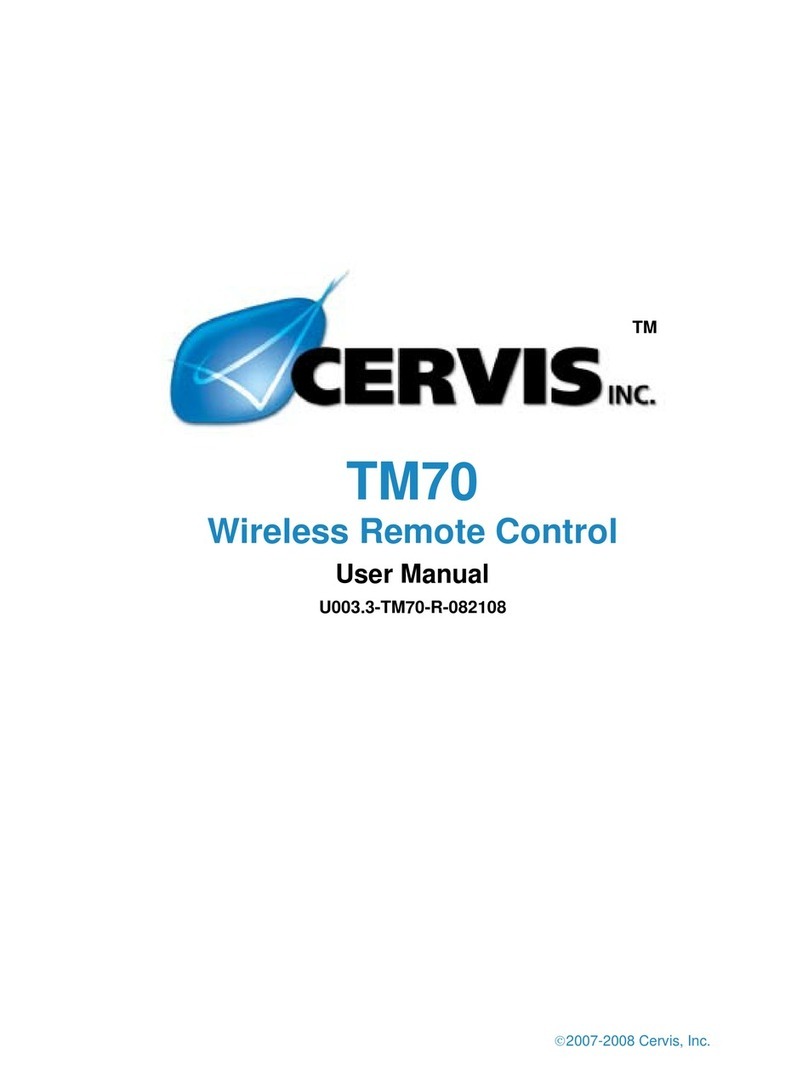
Cervis
Cervis TM70 User manual

Cervis
Cervis TM70 User manual

Cervis
Cervis SmaRT HH-xH06 Series User manual
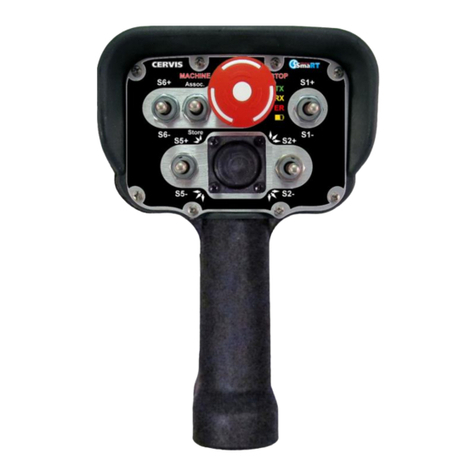
Cervis
Cervis SmaRT PG Series User manual
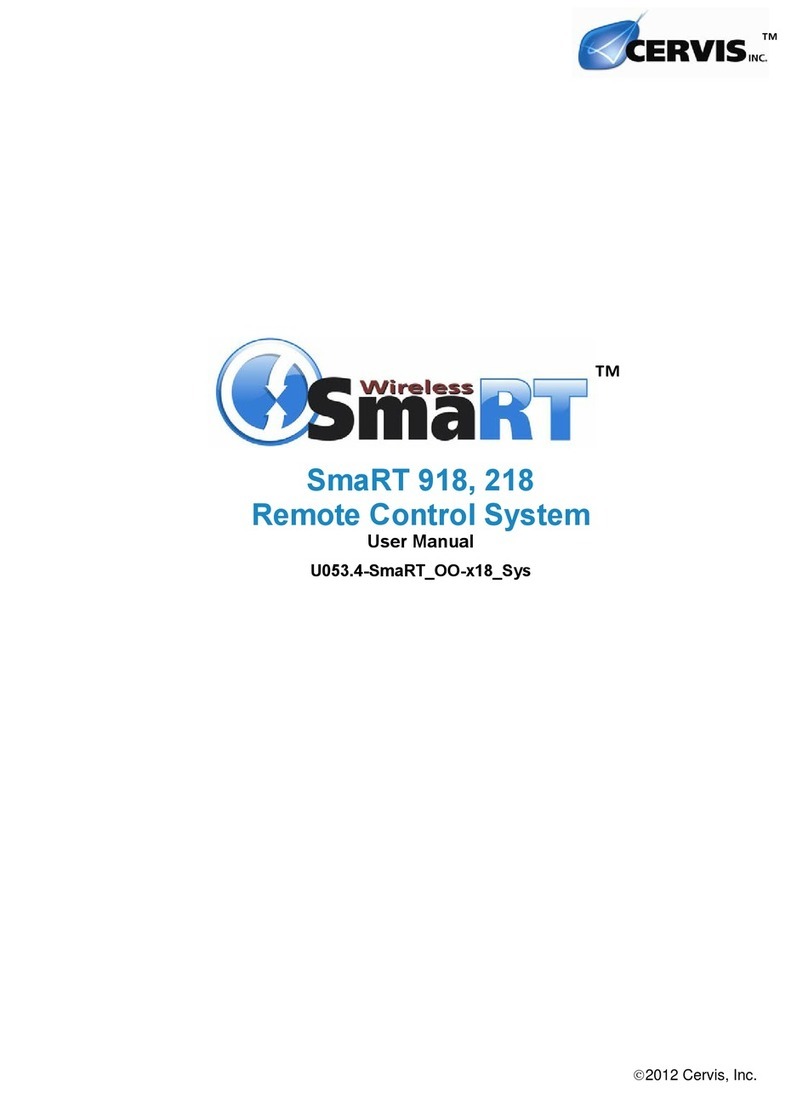
Cervis
Cervis SmaRT 218 User manual
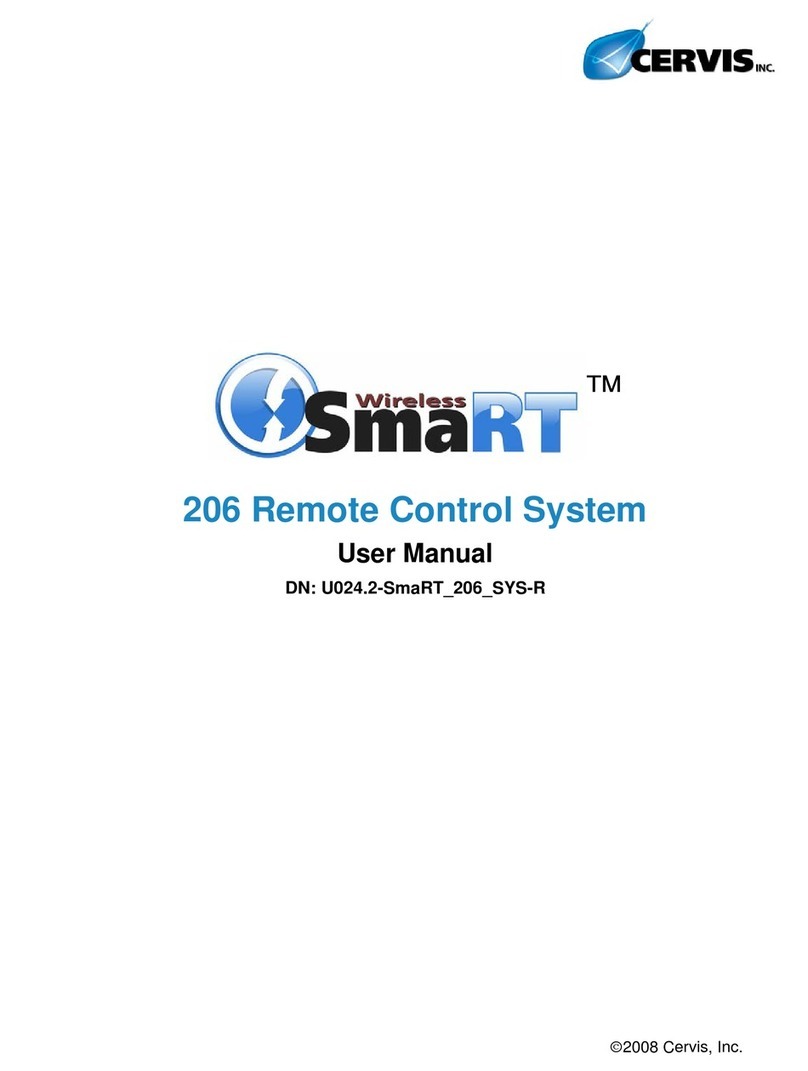
Cervis
Cervis SmaRT 206 User manual
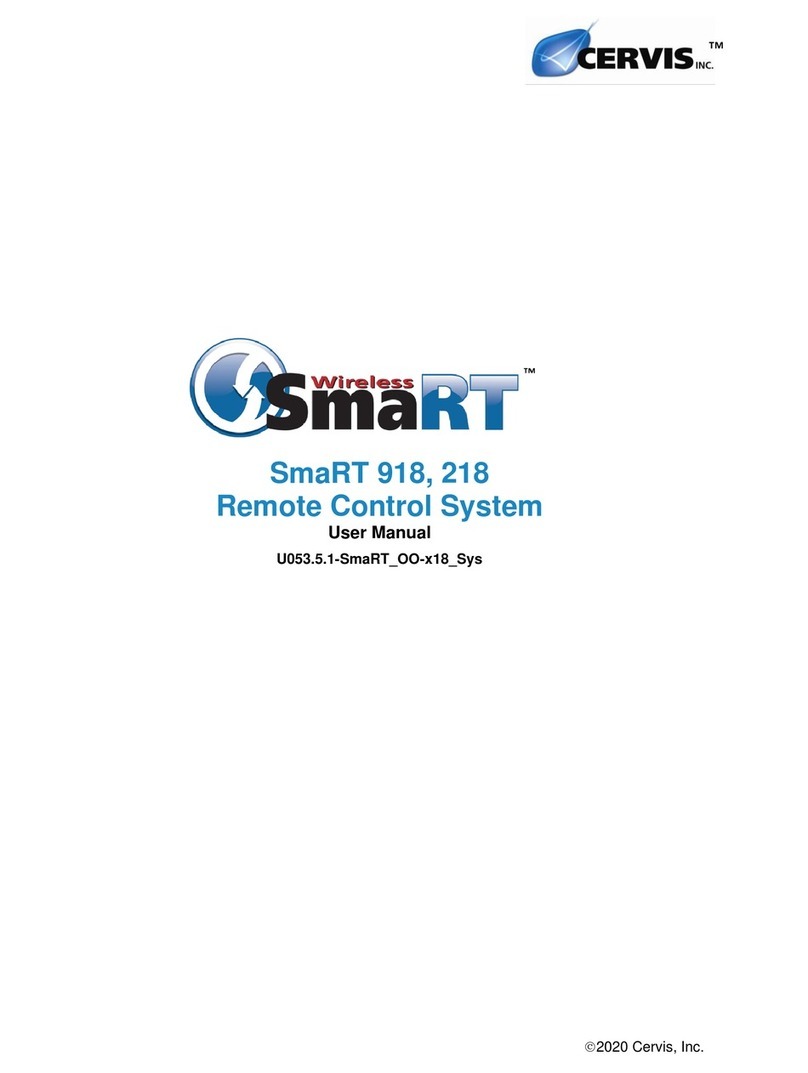
Cervis
Cervis SmaRT 918 User manual
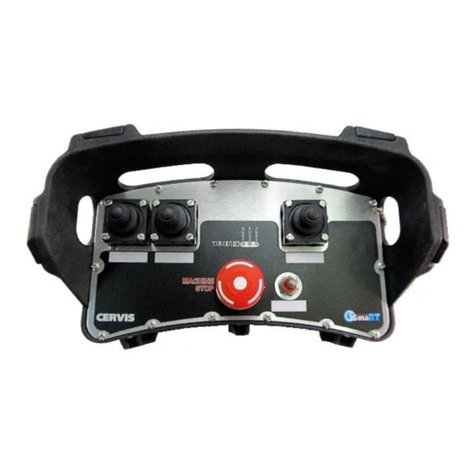
Cervis
Cervis SmaRT CB-xH User manual
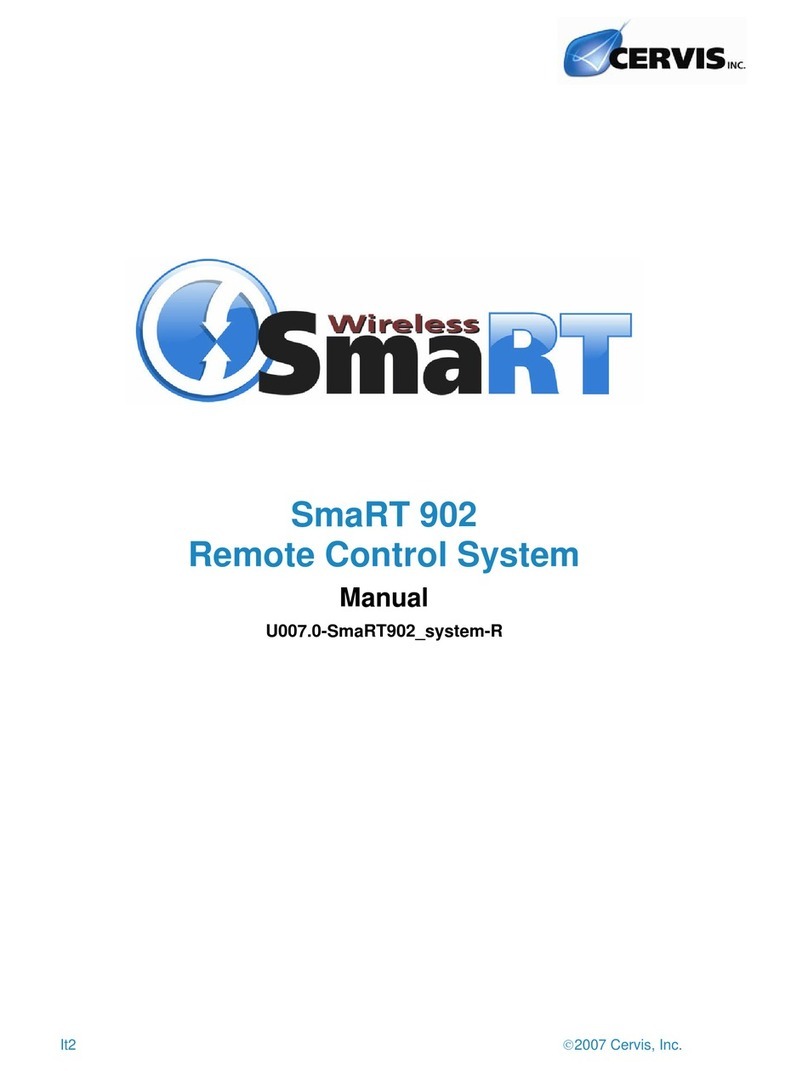
Cervis
Cervis SmaRT 902 User manual
